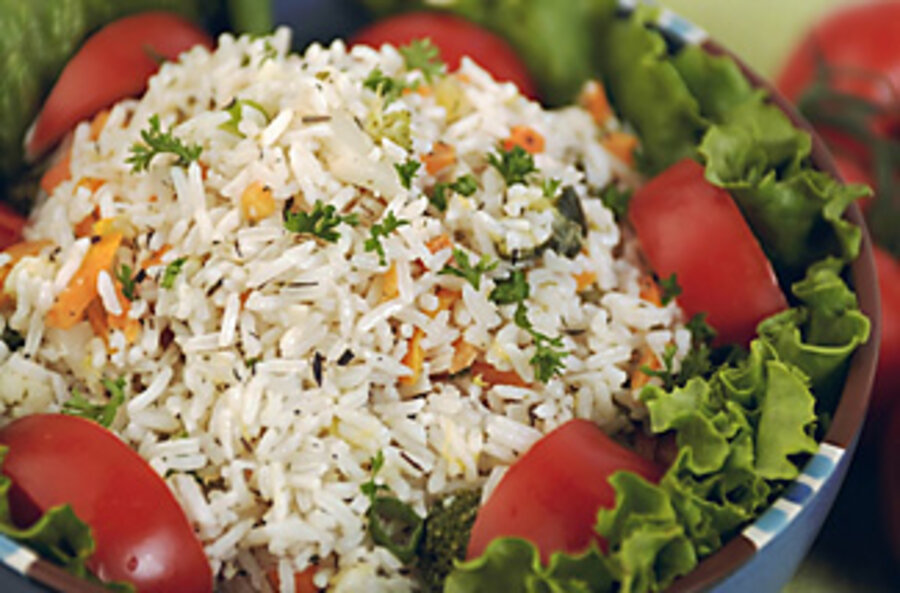You, too, can cook perfect rice
Loading...
Upon entering the house of a good friend in Ipoh, Malaysia, I was greeted by an aroma redolent with spices and herbs. I resisted the urge to head straight to his kitchen to investigate.
In Malaysia, the culture demands a long and courteous conversation between a host and his guest. Hours passed before I could hunt out the source of the aroma. All four burners on a stove held simmering pots. A kerosene stove on the adjacent porch held two more. Three pots contained rice; curries bubbled in others, judging by the scent and the vivid yellow turmeric. I asked our hostess (who supervised a cook): Why three rice pots?
"We always cook three pots of rice, at least once a day," she said. "One for ourselves, that's the white rice; one for our servants, which is brown rice; and a smaller pot for the cats and dogs, that's a lower-grade brown rice. Any leftover vegetables or scraps of meat are thrown into the pet-food pot."
As if on cue, a small herd of cats and dogs arrived. Their stew disappeared in seconds.
It's hard to imagine another food item more versatile than rice. This starchy food can be used at any meal – be it a side dish, a salad, an entrée, a dessert, or even hors d'oeuvres – and costs less than 5 cents a serving. It's a food item worth knowing well.
Rice, just like wheat, is a grass. Both are easy to grow and are the two cheapest foods on earth. They are also the staple foods of the world. Rice was among the first cultivated American food plants on the wetlands near Charleston, S.C., in 1694. Rice farming spread throughout the southeastern states during the next two centuries and reached California in 1912. Rice thrived in the American West, and northern California is now one of the best and highest yielding rice-growing regions in the world.
As a side starch dish, rice is valued for its sauce-absorbing quality, rather than its nutrition. Brown rice, which includes the bran and the germ of the rice grain, is slightly higher in nutritional value and more flavorful.
All good cooks should have the three basic types of rice on their shelves: white long-grain, white short-grain, and brown long-grain rice. Aromatic rices include jasmine and basmati, and some insist on Italian short-grain arborio rice for risotto. When you prepare rice dessert dishes, short-grain sweet rice is your choice.
There are two ways to cook rice. You can cook it like pasta – in plenty of boiling, salted water until tender; drain, and serve. Or you can used the absorption method: steaming rice in precisely measured amounts of salted water. By the time the rice is tender, it has absorbed all the water and is ready to serve. It also retains all of its nutrients.
When cooking with the absorption method, use a fairly tall pot so the escaping starchy water won't run all over your stove top. To cook 1 cup of raw rice, serving three to four, start with 1-1/2 cups water and 1/4 teaspoon salt. For each additional cup of rice, add 1-1/4 cups water and 1/4 teaspoon salt.
Bring the water and salt to boil. Stir in the rice and when the water is simmering, reduce heat to low and cover with a lid, but leave a small crack for air. Set the timer to 15 minutes for white rice, 40 minutes for brown rice. Check for tenderness and, when done, cover competely and set aside for five minutes, then serve. Be careful not to stir the rice while it is cooking, since this releases starch and makes the rice sticky. Adding a little butter or oil to rice after cooking also keeps the grains from sticking.
Learn a good rice-cooking technique, practice it regularly, and you'll invariably end up with fluffy, perfectly cooked rice grains every time.
Rice Salad
Do you have a good pasta salad recipe? Substitute cooked rice for pasta for a twist on a familiar side dish.
1 cup uncooked rice
Dressing of your choice, to taste
2 cups of salad vegetables, chopped
Use white, brown, wild, or a combination of rice. When finished cooking the rice (see article above for instructions), add salad dressing to the rice while still warm, then stir in vegetables. Chill for several hours, but for best flavor, serve at room temperature. Serves 6 to 8.
Italian Rice Fritters
3/4 cup uncooked white short-grain rice
1-1/4 cups milk
1/4 cup sugar
1-1/2 teaspoons fresh-grated lemon zest
1/4 teaspoon salt
2 eggs, separated
Oil
Combine rice, milk, sugar, lemon zest, and salt in a 1-quart saucepan and bring to boil on medium heat. Stir often. When the rice is simmering, reduce heat to low, cover pot partially, and cook until all milk is absorbed, 15 to 20 minutes. Cool until warm to the touch.
Combine egg yolks with cooked rice.
Beat egg whites to soft-peak stage and gently fold into rice.
Drop small kiwi-size pieces on the hot surface of a skillet coated with a thin film of oil. Brown about three minutes, flip over and brown second side. Set on paper towels to drain. Serve hot, dusted with powdered sugar or drizzled with honey. Makes about eight fritters, serves 4.
Source: Modified from C. Quigley, USA Rice contest finalist





